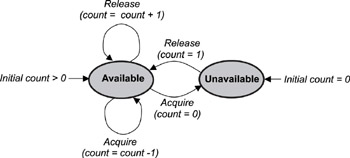Книга: Real-Time Concepts for Embedded Systems
6.2.2 Counting Semaphores
6.2.2 Counting Semaphores
A counting semaphore uses a count to allow it to be acquired or released multiple times. When creating a counting semaphore, assign the semaphore a count that denotes the number of semaphore tokens it has initially. If the initial count is 0, the counting semaphore is created in the unavailable state. If the count is greater than 0, the semaphore is created in the available state, and the number of tokens it has equals its count, as shown in Figure 6.3.

Figure 6.3: The state diagram of a counting semaphore.
One or more tasks can continue to acquire a token from the counting semaphore until no tokens are left. When all the tokens are gone, the count equals 0, and the counting semaphore moves from the available state to the unavailable state. To move from the unavailable state back to the available state, a semaphore token must be released by any task.
Note that, as with binary semaphores, counting semaphores are global resources that can be shared by all tasks that need them. This feature allows any task to release a counting semaphore token. Each release operation increments the count by one, even if the task making this call did not acquire a token in the first place.
Some implementations of counting semaphores might allow the count to be bounded. A bounded count is a count in which the initial count set for the counting semaphore, determined when the semaphore was first created, acts as the maximum count for the semaphore. An unbounded count allows the counting semaphore to count beyond the initial count to the maximum value that can be held by the count’s data type (e.g., an unsigned integer or an unsigned long value).
- 6.2 Defining Semaphores
- 6.2.3 Mutual Exclusion (Mutex) Semaphores
- 6.3.1 Creating and Deleting Semaphores
- 6.3.2 Acquiring and Releasing Semaphores
- Chapter 10. IP Accounting
- Configuring the Kernel for IP Accounting
- Configuring IP Accounting
- Accounting by Address
- Accounting by Service Port
- Accounting of ICMP Datagrams
- Accounting by Protocol
- Using IP Accounting Results




